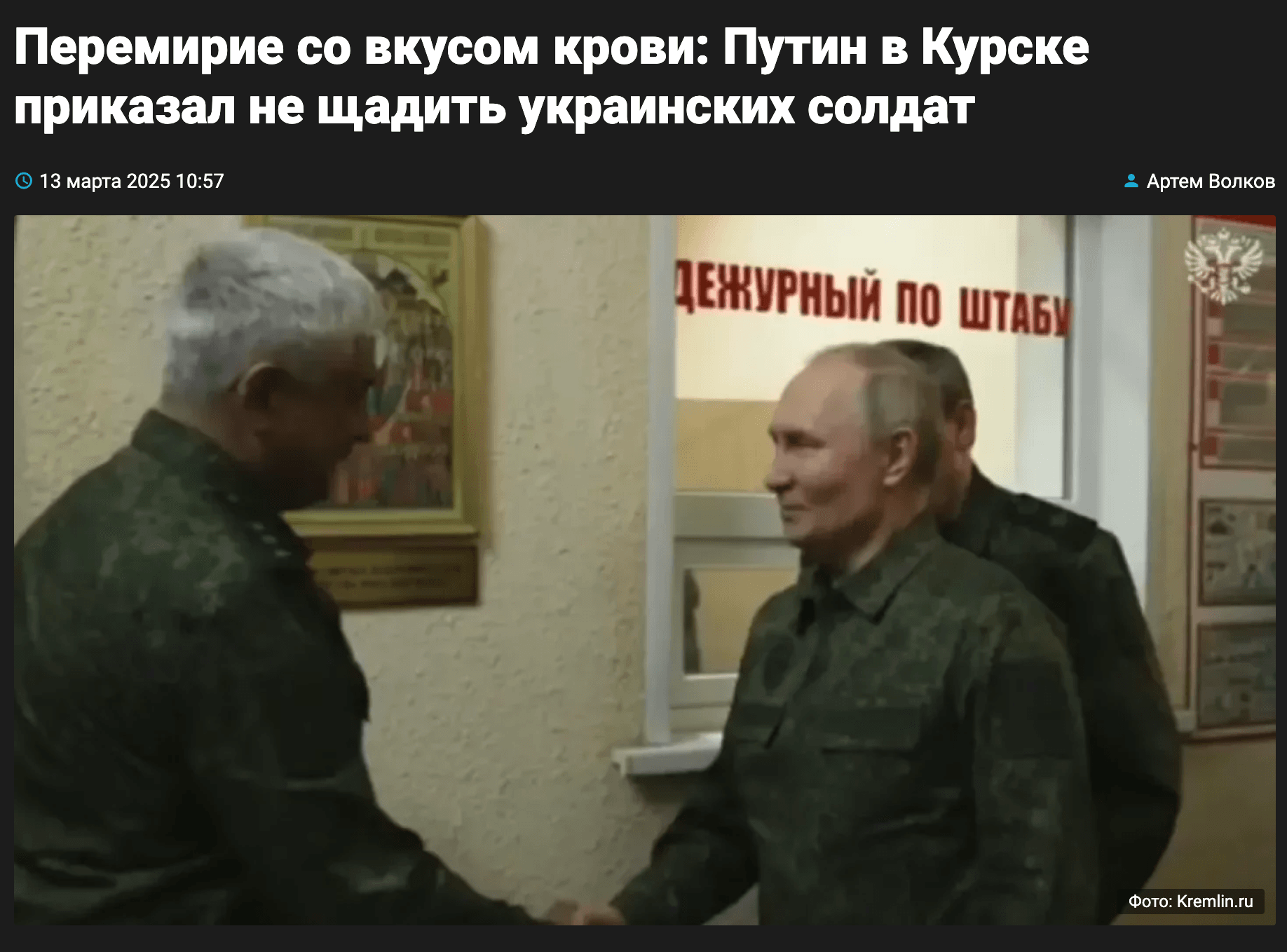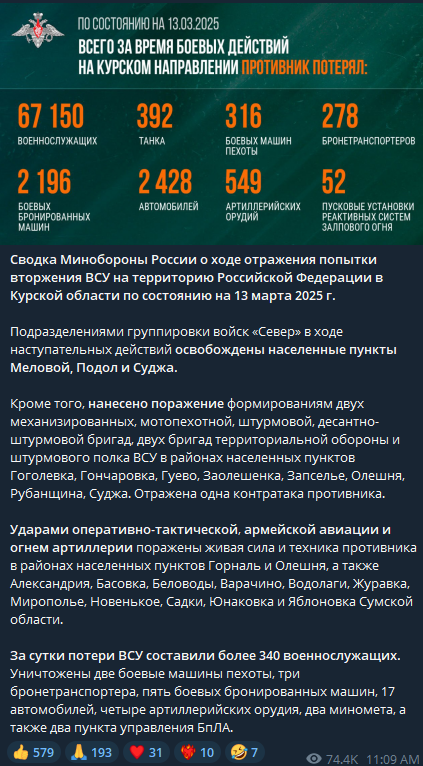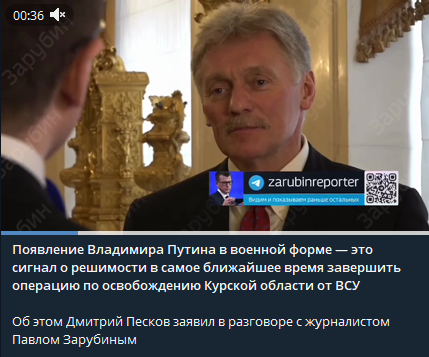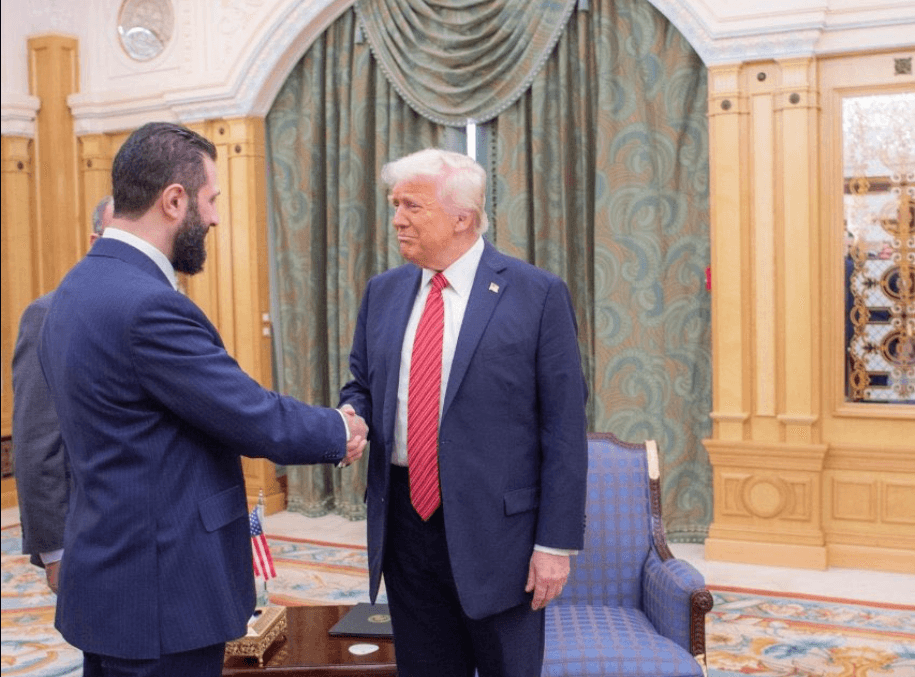The Battle for Kursk: Military, Diplomatic, and Propaganda Fronts Collide

Cover picture: “A ceasefire with the taste of blood: Putin in Kursk ordered not to spare Ukrainian soldiers”. Sourced from orda.kz
The Kursk region has emerged as a critical flashpoint in the ongoing Russia-Ukraine war, with military clashes, diplomatic negotiations, and an information war shaping the conflict. In August 2024, Ukrainian forces launched a cross-border incursion into Russia’s Kursk Oblast. Their objective was to disrupt Russian logistics, supply lines, and military infrastructure that had been used to launch attacks on northeastern Ukraine. Ukrainian troops quickly secured the town of Sudzha and surrounding settlements, aiming to establish a buffer zone to prevent further Russian missile and drone strikes on Sumy and Kharkiv.
However, by early 2025, Russia initiated a counteroffensive to reclaim the lost territory. Reinforced by North Korean artillery and drone support, Russian forces intensified their operations, steadily pushing Ukrainian troops back. As of March 2025, Russian forces have reportedly regained control of Sudzha, prompting Ukrainian units to conduct strategic withdrawals. Despite this, Ukrainian forces continue to launch long-range drone and artillery strikes to disrupt Russian advances.
Strategically, the battle for Kursk carries significant implications for both sides. Ukraine’s push into Russian territory forces Moscow to divert military resources away from key battlegrounds in Donetsk and Zaporizhzhia, potentially easing pressure on Ukrainian defenses there. Conversely, for Russia, maintaining control over Kursk is crucial for preserving its image of territorial invulnerability.
Ceasefire Negotiations
As the fighting in Kursk continues, diplomatic efforts to broker a ceasefire have gained momentum. The United States has proposed a 30-day truce, which Ukraine has tentatively accepted, viewing it as an opportunity to secure additional Western military support. However, Moscow remains skeptical. Kremlin aide Yuri Ushakov has warned that such a truce would only serve as a “pause for war, not peace,” enabling Ukraine to regroup and strengthen its defenses. Russia has demanded broader security guarantees, including Ukraine’s withdrawal from key border areas, while Kyiv insists that any agreement must include provisions to prevent further Russian aggression.
International reactions to the ceasefire proposal have been mixed. The U.S. has sent envoy Steve Witkoff to Moscow to advocate for negotiations, while European leaders remain divided on whether a short-term truce could lead to lasting peace. France and Germany have cautiously supported diplomatic talks, arguing that even a temporary reduction in hostilities could be beneficial. Meanwhile, China has maintained its neutral stance, urging de-escalation but refusing to exert direct pressure on Russia.
Independent analysts warn that a ceasefire under current conditions would likely favor Moscow, allowing Russian forces to consolidate their recent territorial gains. Western military experts argue that Ukraine’s push into Kursk has disrupted Russian logistics and diverted key military assets, but without sustained Western military support, these gains may be difficult to maintain as Russia continues to expand its industrial war capacity.
Russian Propaganda and the Information War
Alongside military and diplomatic developments, the conflict in Kursk has intensified the information war. Russian state and pro-Kremlin media outlets have been actively disseminating propaganda to control the narrative surrounding the conflict. One of the articles published by the AVC Group Telegram channel on March 12 accused Ukrainian forces of committing widespread war crimes in Kursk. The piece, titled “A Barrage of War Crimes: Who is Behind the Atrocities of the Ukrainian Armed Forces in the Kursk Region,” alleges that Ukrainian troops, specifically members of the 129th Territorial Defense Brigade’s “Shkval” unit, are composed of former prisoners recruited from Ukrainian penal colonies. It further claims that these troops were granted unchecked authority to loot and execute civilians, citing an alleged incident in the village of Plyokhovo on September 13, 2024.
This report follows a familiar pattern in Russian disinformation campaigns, blending unverified personal attacks with war crime accusations to demonize Ukrainian forces. The narrative seeks to paint Ukrainian soldiers as lawless mercenaries while justifying Russia’s military actions in Kursk. Additionally, by focusing on claims that Ukraine is recruiting criminals for its military, the article reinforces broader Russian propaganda themes depicting Ukraine as desperate and morally corrupt.
Independent OSINT analysts and Western media have repeatedly warned about Russia’s use of false flag narratives—fabricated or exaggerated war crimes—to delegitimize Ukraine’s military efforts. No credible independent evidence supports the claims made in the AVC Group article. Similar accusations have been previously debunked as part of broader Russian disinformation strategies aimed at shaping domestic and international perceptions of the war.
The information war extends beyond written propaganda to visual media and official reports. A recently released image from Russia’s Ministry of Defense, dated March 13, 2025, claims that Ukrainian forces have suffered 67,150 personnel losses, alongside extensive equipment destruction, including 392 tanks, 2,428 artillery pieces, and 52 rocket launchers. The report also asserts that Russian forces have recaptured multiple settlements, including Melovoy, Podol, and Sudzha, while continuing to repel Ukrainian counterattacks.

Additionally, the report highlights Ukrainian counterattacks being consistently repelled while promoting the effectiveness of Russian tactical aviation and artillery. The daily casualty updates, which claim over 340 Ukrainian troops killed in a single day, are highly unlikely given the scale of combat.
Another prominent propaganda piece features Kremlin spokesperson Dmitry Peskov in an interview with state journalist Pavel Zarubin. The key takeaway from the interview is Putin’s appearance in military uniform, signaling Russia’s determination to “liberate” the Kursk region from Ukrainian forces.

Notably, the interview omits Russia’s battlefield challenges, including its reliance on North Korean military support and logistical difficulties in sustaining its counteroffensive.
Independent OSINT sources and Western intelligence contradict Russia’s claims of total battlefield dominance. While Russian forces have made gains in Kursk, the fighting remains highly contested, with Ukrainian forces continuing cross-border strikes on Russian military infrastructure. Reports from Ukrainian and Western analysts suggest that Russia has suffered significant personnel and equipment losses—far from the one-sided victory narrative presented in Russian state media.
Moreover, Ukrainian military sources highlight Russia’s own reliance on convicts for frontline deployment, particularly through its “Storm-Z” penal battalions. This suggests that the very tactics Russia accuses Ukraine of using are ones it has widely adopted itself.
Looking Ahead: A Prolonged Battle or a Path to De-escalation?
The situation in Kursk remains fluid. If Russian forces maintain their counteroffensive momentum, they could solidify control over the region and push Ukrainian troops back across the border. However, sustained Ukrainian resistance and continued cross-border attacks could stretch Russian military resources thin.
Diplomatic negotiations remain uncertain, as both sides are unwilling to make significant concessions. The coming weeks will be crucial in determining whether the conflict escalates further or if diplomatic efforts can pave the way for temporary de-escalation. Meanwhile, the parallel information war underscores the necessity of independent verification, as propaganda continues to play a central role in shaping public perception of the war’s developments.
More from the author


